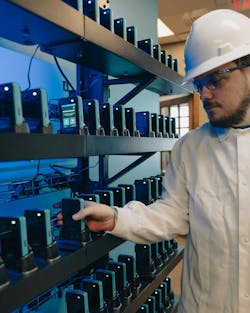Stella and Chewy is a premium pet food manufacturer, focused on a minimally processed, raw diet for dogs. It sells product frozen, freeze-dried or lightly baked and coated with a raw product made during the freeze-drying process.
Mark Sheard, plant engineer at Stella and Chewy, has worked at the facility for almost eight years, and before that, for more than a decade, he worked in human food production. “They are very similar processes,” from a regulatory standpoint to certifications and safety issues to the equipment and OEMs, Sheard says. “So many of those things cross over between the two industries.”
One of those crossover points is the challenge of keeping maintenance, operations, and management in contact to ensure hiccup-free production and rapid responses to any problems on the plant floor. Sheard and his team have started to overcome those challenges with a new radio communication system that enables workers to share real-time information with each other, from voice and text to images and alerts.
The production process and maintenance focus
The pet food production process is very similar to typical meat production. “We bring in frozen block ingredients. We go through a grind step, where we create our different recipes or diets,” Sheard says. The product goes through a clipping process to make 15-pound sausage chubs. The product then goes to a high-pressure processing (HPP) machine for sterilization. “Since we’re raw, we don’t cook, where you’d normally use heat to kill bacteria,” he adds. The raw meat is subjected to 86,000 PSI of pressure, which kills any bacteria.
The HPP is the plant’s most technical machine. “Anytime you’re subjecting a piece of equipment to that many pounds of pressure, it’s cycle-based maintenance,” he adds. The machine does experience failures and leaks occasionally, and there’s a lot attention on that piece of equipment. “From a safety factor, there’s a lot of responsibility that goes with that,” Sheard says.
Then, the product moves to the forming department, where it is pumped into a die to create different shapes. “We can change those dies out for the different shapes we make,” Sheard says. Next, some product is frozen in a spiral freezer, packed frozen, and sold that way. The freeze-dried product goes onto pans and into freeze dryers.
“The freeze-drying process is creating an environment below the triple point of water, so the water going directly from a solid to a gas, and drying all that moisture out of the product. You lose about 75% of your weight in that product in that process. Product comes out very light and shelf stable at that point,” Sheard says.
All of the product at the plant is sorted to guarantee a premium product, looking for any type of foreign material, defects, or broken pieces. “Then, we go through a finished goods packaging. We package in a variety of different sizes,” Sheard says.
Product goes through an automatic scale system for measurement, then an automatic bagging system. “We do a nitrogen injection, like a modified air packaging system for longer shelf life,” he adds. Then, product gets checked again, weighed, metal detected, boxed up, and sent out the door.
“We don’t have any finished goods warehousing on-site. That’s all done through third-party warehousing,” Sheard says.
Production, for the most part, runs two shifts, then a third shift sanitation cycle. The plant does have some processes that run longer. The freeze dryers run between 14 and 20 hours, depending on the recipe. The plant runs 45 different freeze dryers in batches. They load and unload three dryers with product every hour, running 24/7. The sorting department for those finished goods and the panning department that fills trays before freeze drying also run seven days a week. “From a maintenance perspective, I’ve got mechanics on 24/7 coverage, supporting the operations group,” Sheard says.
Every night the entire production area goes through a washdown. Even with NEMA 4X-rated equipment, “Water and electronics never get along,” Sheard says. “We try to keep fighting fires to a minimum and focus on the preventive maintenance.”
Improved communication for real-time repairs, documentation, automatic translation, and more
This year the plant upgraded to a new radio communication system. Prior to that upgrade, the plant used traditional two-way radios, but only maintenance, supervisors, and management had radios. With the Weavix Walt Smart Radio System, all the 600+ employees in the operation have one on hand. Sheard says that has added both a sense of ownership and greatly expedited communication. “Now you don’t have to wait, if you have an issue on a machine,” he adds.
Typically, a general laborer or the machine operator would have to find a supervisor, or someone who has a radio. “Now they can directly call on the maintenance request channel, and they’re directly in contact with the maintenance team,” Sheard says.
In addition to real-time updates, the smart radios provide more detail with photo and video capabilities. “Even before the maintenance team goes to the floor, we’ve got pictures. We’ve got videos of what’s happening,” Sheard says. “If it’s something common. We know we need this part. We can bring these parts with us.” The dialog back and forth speeds up repairs, he adds.
The radios also do automatic translation. “We have a lot of different languages that are spoken here,” Sheard says. “Having that translation factor really breaks down some of those communication barriers.” Users can also speak or type into the device, depending on their preference.
Form a management level, it also provides documented communication chains. “If there’s a question on what happened last night,” Sheard says, “here’s the chain of events and how they occurred.” It’s also helpful for problem solving after the fact, or root cause analysis.
The ‘read receipt’ function is also indispensable, Sheard says. With a standard radio, you need a verbal ‘copy’ to know someone has received a message. The plant often didn’t have good coverage everywhere with the old radios, but this verification comes automatically.
Better training and culture make for faster decision-making
For the new setup, the IT team did extensive testing to make sure the Wi-Fi system could handle the smart radio communication. The maintenance team oversees three different buildings on the block, so with the addition of LTE coverage, they have communication in all buildings and en-route between them. Other internal departments have benefited from the new network too. “The combination of Wi-Fi and LTE has provided a boost of communication that we didn’t have before,” Sheard says.
Workers can also access system communications via a mobile app, which on the management side, Sheard finds helpful. “The mobile app is really nice for after-hours support,” he says. “I’ve got a direct line of connection to anybody in the plant with radios.”
The radios have a device management rack, the Walt PowerWall, for charging and storage (Figure 1). “We’ve added the Walt as part of our GMP [good manufacturing process],” Sheard says. “Before you enter the production facility, you put on your hair net, you put on your ear plugs, you put on your overcoat, and you grab the Walt.” The radios are also used for emergency communication, such as evacuations or safety programs, or a company announcement channels for general information.
The plant explained the new communication systems to the workers long before the radios arrived. “We had townhalls with every single employee, explaining this is what it is, this is why we’re doing it, this is what the expectation is. Then, we had training set up,” Sheard says, to try to remove all the hurdles of entry when they started the process.
Overall, Sheard adds, the Weavix Walt Smart Radio System “creates a faster decision-making process. The faster you can get the facts and understand what’s going on, the faster you can make a decision to get equipment back up and running.”
About the Author

Anna Townshend
managing editor
Anna Townshend has been a journalist and editor for almost 20 years. She joined Control Design and Plant Services as managing editor in June 2020. Previously, for more than 10 years, she was the editor of Marina Dock Age and International Dredging Review. In addition to writing and editing thousands of articles in her career, she has been an active speaker on industry panels and presentations, as well as host for the Tool Belt and Control Intelligence podcasts. Email her at [email protected].

